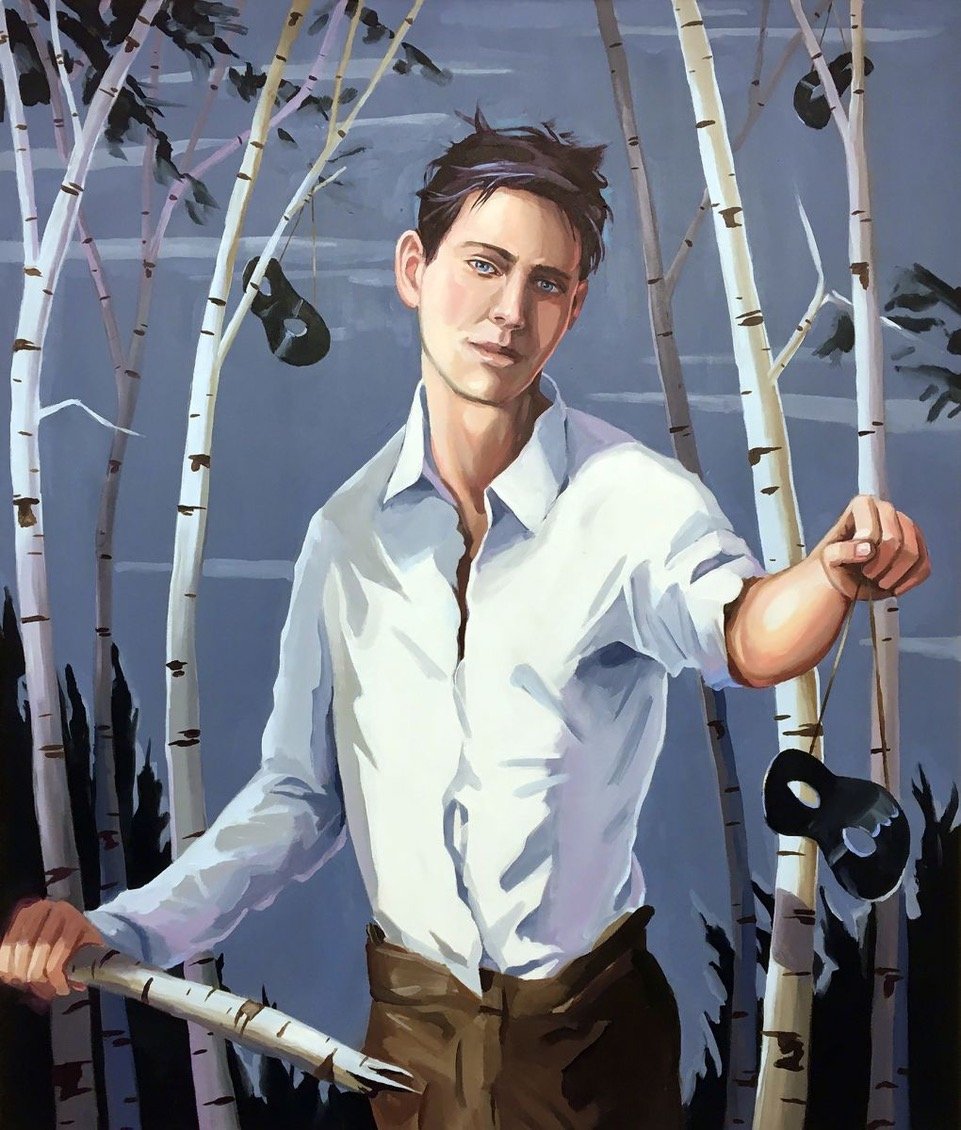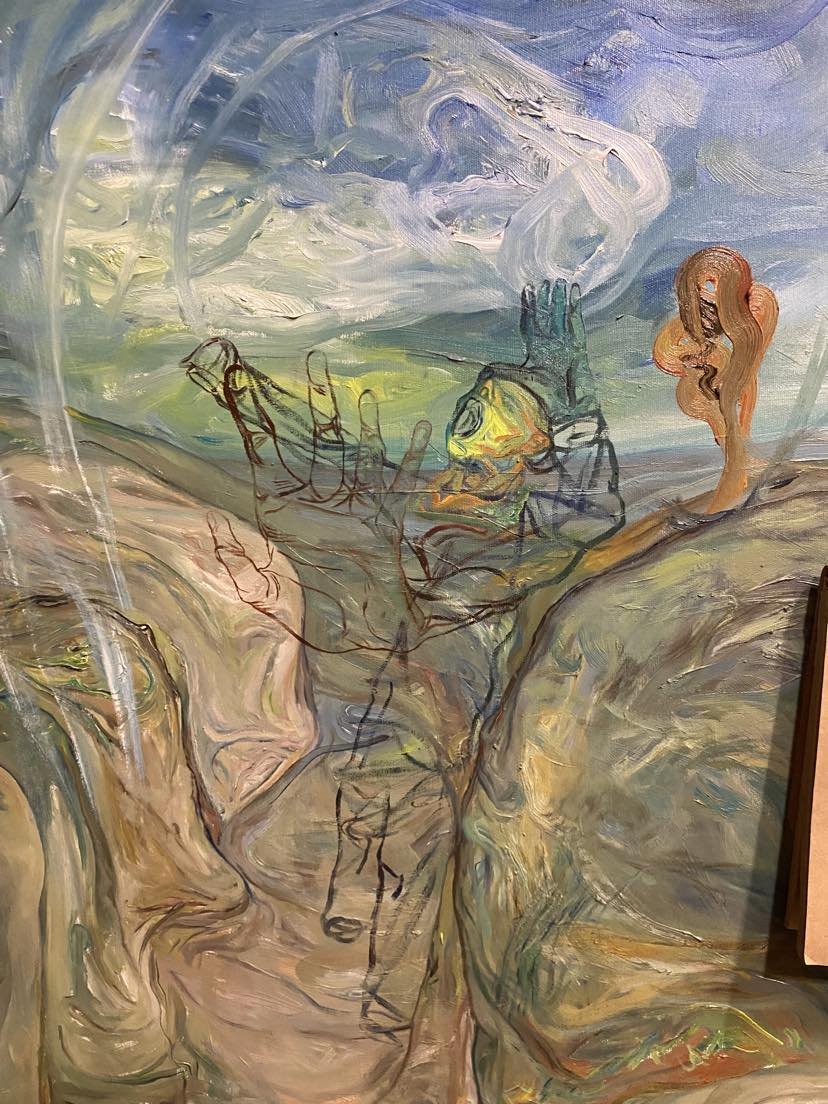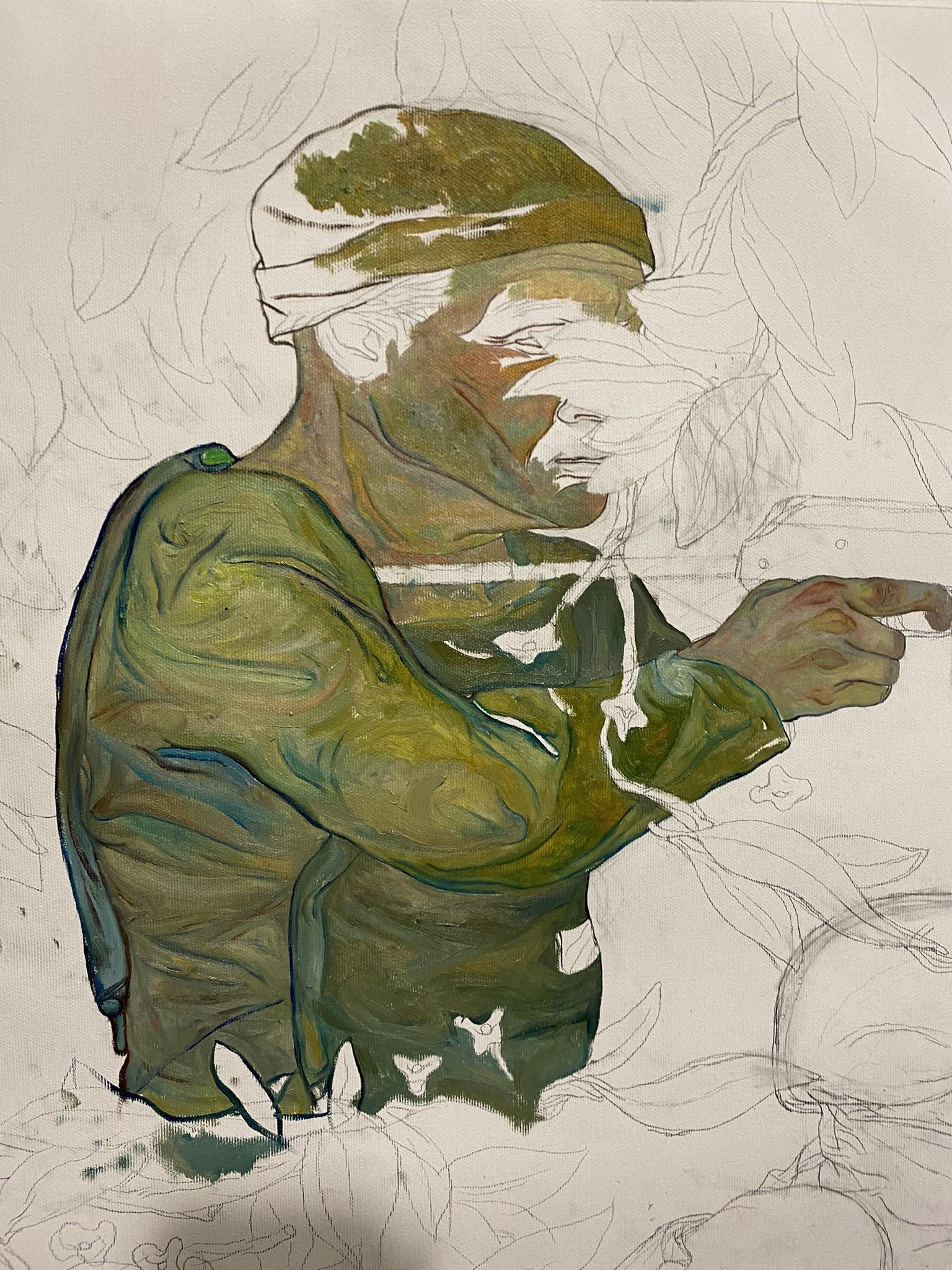International Paneling/July 2023
Image by Hortser
Is Social Media a Drug? Or “Does Daddy Need his Medicine?”
by Leo Kuelbs
Berlin
Though it seems to fly a little bit under the radar, it appears to be well known that social media use/abuse can be addictive. You get a little dopamine rush when you hear the bell and when you click on the next outrageous headline. I mean, don’t we all agree that the unregulated dangers of uncontrolled use of social media is a risk to the individual, as well as the larger group?
If you watch entertainment as news for hours and hours a day, you might just be feeding dopamine to a lowly beast living inside of yourself. Whether it’s on the left or right, a diet of seemingly righteous, indignant outrage has become a staple in the daily diet of many. It’s funny that so many seem to have become addicted, dependent, reliant on these experiences as a means to fill some great holes or needs within the self, the population. Does this stuff make you feel bigger, better, more educated than those around you? Why is it happening? Is it that this relatively new invention is just too powerful to resist? Also, isn’t it obvious that this endless “research” is really a means of dosing and shaping yourself into a particular type of widget, more easily classified and manipulated by advertising interests eager to keep your eyes glued to a site or channel in hopes of attracting more advertising dollars?
The strange thing I notice is that some of those connected to myself would accuse their perceived enemies or threats as being shaped by SM towards adversarial purposes, while the judger is literally doing the same thing. No matter where you sit, it’s become pretty clear that projection of bad behavior indulged on one side and assigned to the other is a basic power move. This has gone on forever. I mean, some of the right is now striving towards the “big government” moves formerly associated with their opposing counterparts. Maybe it’s all like a big “Game of Thrones” story where we ocilate back and forth between blaming each other for the same old moves. Even though the digital reality is here, it does seem like the basic human impulse control and gears are still mostly intact. After like a couple of million year. Is it wrong to have hoped for more?
Aren’t terms like “divide and conquer,” so baked into our shared gospels and rhetoric, as to be hyper obvious? Breath. If so, then why are so many so eager to fall prey to losing parts of their actual humanity/individuality in trade for another helping of outrage at the perceived other?
It could be that in this massive population that roams the earth, knowledge or curiosity of the self and those around us in dangerously short supply. When the “globalists” get attacked, isn’t that a move that displays a desire to remain in our little particular bubbles and not experience a potential growth in empathy that meeting strangers can provide? Isolate, organize, divide, use blame to manipulate—these seem to be the rules of the day. And the little dopamine rush is how it happens. It seems like you can get a lot out of that little rush.
It seems that a huge percentage of the world is in denial…Is it time for an intervention?
What to do about it? It seems that a huge percentage of the world is in denial. And those who profit from this massive dumbing down and addiction manipulation aren’t interested in moving anything meaningful forward. Is it time for an intervention? I think those who might actually benefit from some harsh but caring words are so addicted to their “medicine” as “research” and “study” that they would absolutely lose it. Don’t take away daddy’s outrage drug or he might blow a fuse.
I guess the hope is that the younger generation will somehow take this situation in hand and start ignoring the online fast food, as the older generation—born before the ascendency of digital—fades away. Or maybe there’s a different way that I am too old to see. It’s a lot to ask as these kids are suffering already under a big boomer crew that is love with its medicine, as well as a system that’s happy to keep them hooked.
It’s going to take some introspection and evolution to improve things, and my hope is that we can start talking about this important issue more right now. Many have become so addicted to this stuff that they forget who their real friends and family are while they actively become what they have railed against in the past. It is so sad and seemingly obvious that I can only have hope that it will get better through actual human interaction.
Shorty of the Week! Nicole Antebi’s "Agents of the Chihuahuan Desert"
Not long before COVID roared to life, the show DIGITAL FAIRY TALES: Vengeance is Mine appeared at the IFP Made in New York Media Center in Brooklyn, as well as LIGHT YEAR 48, on the Manhattan Bridge. The show explored themes of vengeance and its self-perpetuating nature.
From the show’s text: When one encounters the term “Vengeance,” it is with excitement, suspicion and dread. For vengeance to exist, there must be a prior perception of victimhood, a grievance. The scale of which is determined by the protagonist, but the roles can quickly be flipped. And flipped and flipped again. The chain of vengeance can go on and on and, unless broken, lead to ever escalating levels of calamity.
Nicole Antebi’s excellent animation “Agents of the Chihuahuan Desert” considers these ideas with immigration at the southern USA/Mexican border in mind. Surely, immigration is a difficult issue with no easy answers. It’s unavoidable, and painful from all perspectives, it seems. Nicole Antebi was raised in these same borderlands, and her name is of Syrian origin, and refers to the border city, “Gaziantep,” near Aleppo. The universal nature of border people and border lands, the meaning of boundaries, politics and humanity have been a part of her work for many years. Anyway, let’s take a peek on this great video from 2019. Check the link for more on Nicole Antebi.
Image by ANANI
POETRY PLACE
by Sanj Nair
Virginia Beach
Branch, Twig, Thorn
The branches that root and grow in the body
are more than Daphne’s dark history:
The way the tender base begins in the pelvic base of bone,
a place where who knows what may grow, later—
the twigs of living branching toward the sternum,
the twisted leaves of the classrooms we’ve occupied—
the triumph of winning that high school match or
the friend who whispered about her parents’ fights that
nearly drove her to pills and knives—
the branching continuing into the base of the skull, and
the way a magnolia opens and blooms there with
that first, hesitant kiss, then the thorns that grow
into the rosy limbs of arms after love fails, and then
finally, the hands, the camelia hands,
blushing into deep, red bloom when
the moment comes and each of us begins to realize, even
if it’s at 50, that all this, too, was youth:
The hands, where self-love resides.
Now, go plant something.
Image by Juliane Pieper
Moving Apartments: The New Normal in Berlin
by Adrian Pocobelli
Berlin
The struggle of renters in today’s major cities is a common tale—too few places at higher and higher prices, with queues of people desperate to lock in what would have been considered terrible deals only two to three years ago.
Berlin, of course, is one of those cities that are notoriously difficult to find a dwelling; where one hears all sorts of anecdotes about people moving from sublet to sublet for three to four months at a time for a year or two before finding something more permanent. “I can’t work on any projects because I’m constantly moving,” you’ll hear. It’s so precarious that to find a temporary two-year contract (which are more and more common and you have to build your own kitchen) is considered a major win these days.
This writer was not immune to this situation, having recently received the dreaded Eigenbedarf—the order to leave based on the return of the landlord or a family member to the dwelling to live. Often this is the easiest way for landlords to evict tenants, as generally the rules are actually quite strict in tenants’ favor in Berlin. If the landlord turns out to be lying about moving back in, the most a tenant can hope for is to sue for damages later (as well as, interestingly, be the first in line to take over the apartment once the new tenant’s contract is finished).
So far, my subjective experience of looking for a place went from quiet optimism, to mild terror, to relaxed fatalism. The web search was basically useless for anything that wasn’t super expensive. The reply button on Craigslist (my secret weapon last time) weirdly didn’t even work, while most apartments were available only through an exchange of apartments, or as temporarily furnished, which more landlords are doing in order to avoid the obligations of long-term rental contracts.
The approach that’s yielded the best results we’re through inquiries with friends. My girlfriend’s sister’s ex-husband was going away for work temporarily, so there was an opportunity there (800 euros), while another friend had a friend that was looking to rent a room (800 euros). Another friend’s girlfriend was renting her place, but she wanted 1300 euros for a 50 square metre apartment. And this is a common practice out here—people with old contracts that are paying 800 euros or less then illegally sublet the apartment at a huge profit. It’s captures the dog-eat-dog nature of renting in the modern world.
…there doesn’t seem to be much appetite for change…any regulation towards income on second or third homes is oftentimes encouraged rather than discouraged. In a sense it’s become the most obvious way to retire well off…
With only four weeks to go, I’ve found a place, although there are still hurdles to achieve, but it’s somewhere to sleep until the next shoe drops. From a legislative point of view, there doesn’t seem to be much appetite for change, as the real estate lobby is quite strong almost everywhere, so any regulation towards income on second or third homes is oftentimes encouraged rather than discouraged. In a sense it’s become the most obvious way to retire well off—buy a second property and rent it out on airbnb or to a renter that will pay your mortgage for you. And if costs go up because of inflation, no problem—just raise the rent. It’s too easy and it’s too obvious, so why wouldn’t people do it?
The housing crisis, in my view, is a result of bad policy that encourages the rich to buy second, third and fourth homes—sometimes an entire building—which in turn prices out new home buyers. The legislative solution is simple, in my view, which is to remove the incentive. In other words, the income on any second or more property in the same jurisdiction should be taxed at 80%. And for those property owners that think this is an offensive idea—why should you have the right to retire off of the backs of poor people?
The Cure: Shows from a Lost World Tour
June 22, 2023 Madison Square Garden
Photo and text by Curtis Flowers
Brooklyn
There are so many things to love about Robert Smith and The Cure, the band Smith has been fronting for some 40-plus years, showing up in your town. They're going to go deep into their catalog and pull out some reworked magic you or your parents first heard after smoking weed with someone who could take you beyond the standard fare of commercial radio. Maybe it's "Love Cats," the jazzy, piano and bass vamp that signaled the band's intention of going beyond the chilly, post-punk minimalism of the band's first three albums. Maybe it was their acoustic-leaning sing-along "Boys Don't Cry,* or the slightly sleazy suggestion Smith delivers in "Let's Go to Bed." Hearing one was more than enough to lure you to the others, but when The Cure dropped the day-glow sunshine of "Close to Me," one of the purest, best pop songs ever recorded, pushing all your chips forward to declare being "all in" was such an effortless move to make.
The 31-song set list the band worked its way through Thursday night at Madison Square Garden—the final night of a three-night stand—was by turns lush and orchestral, infectiously catchy, and promisingly pummeling. Swelling synthesizers building to the brink in favorites like “Plainsong” and “Pictures of You,” gave way to handfuls of perfect pop gems, as in “Just Like Heaven,” and “In Between Days,” before being nudged aside in favor of the band’s secret weapon: tasty, nasty guitar riffs layered over the pulsating, heavy beat of Simon Gallup’s bass lines and the propulsive drumming of Jason Cooper. With a delightfully heavy hand, the band stormed its way through the grimy deep cuts and one-offs that endure and get better with age. “Burn,” from the 1994 soundtrack of The Crow, would be a career highlight in the hands of a lesser band, but with The Cure it’s just one of dozens. There’s also the psychedelic frenzy of “Push,” “Shake Dog Shake,” and “From the Edge of Deep Green Sea” that snapped listeners’ necks out of the perfect, pop grooves Smith has been honing over the last 40-plus years. Four new songs, from the bands forthcoming and much-delayed album Songs of a Lost World, sparkled and shined, a seamless fit alongside others, particularly “And Nothing Lasts Forever,” and “End Song.” I want to hold the vinyl in my hands, as I’ve rarely been so excited by the prospect of being bummed
Chills ran through a collective spine all night long when the band struck the opening notes of songs that transported fans through time to first listens in earlier eras.
With a run-time of nearly three hours and a reported 70 songs in this tour’s cycle to pull from, The Cure trusts that you’re not in a hurry to be somewhere after, and those in attendance at the sold-out arena were happy to confirm. You can’t leave because you never know what you’ll miss. In this case, it was a string of the band’s early minimalism, “Jumping Someone Else’s Train,” 10:15 on a Saturday Night,” “and Killing Another” reworked with the heft and muscle of heard on the band’s later recordings. Chills ran through a collective spine all night long when the band struck the opening notes of songs that transported fans through time to first listens in earlier eras. New songs from the band’s forthcoming “Robert Smith may be only human, but he has a singular ability to never let you down.
Image by Tom Rotenberg
Nerdy Reflections: My Evolving New Friend—A.I.
by Mark Bailey
Minneapolis
Since 2014, my main job has been summarizing news reports on corruption and cover-ups for WantToKnow.info. The website is run by a nonprofit called PEERS, and was founded by a former high level US State Department whistleblower. We do good work, but our website has long been in need of an upgrade. This year, my boss hired someone new to take over while he steps back into an advisory role. The woman he hired made the website upgrade a top priority.
So we've been working on the site's new look for the last couple of months. Our redesign is being rolled out this week. Following the initial rollout, we'll be adding new features to the site on an ongoing basis. One of these features is a widget that recommends related articles when a given news story is selected.
This recommendation widget has sent me down a rabbit hole. What makes a news story recommendable? On a deeper level, how can connections and relationships between news stories be identified by machine logic? These questions have both practical and philosophical implications. Particularly now, in the wake of widespread covid-era media manipulation.
There are over 12,000 news summaries in our archive, each one part of a larger story. Manually identifying and mapping out these larger stories would take forever. But there are data science techniques that make the process more manageable. Since I'm not a data scientist, I've been fumbling my way through these, with mixed results.
It's not too difficult to convert the text content of a news article into a numerical fingerprint that can be compared to other similar fingerprints. And there's something elegant in harnessing the mathematical relationships between texts to augment human curation of those texts. Using a standard natural language processing method, I found and mapped out the mathematical relationships between all of the articles in our archive. For a given article, there is now a list of its ten closest matches, based on something called TF-IDF vector cosine similarity.
All of this is very nerdy. And my Python-literate friends are probably tired of my text messages about various specific problems I'm encountering. The last time I did a big project like this was in 2018. Back then, I relied mostly on Stack Overflow to get through the tough spots. This time around, I'm experimenting with ChatGPT for the same purpose.
What I'm finding is that ChatGPT is kind of like having a friend that wants to help but doesn't really know to.
What I'm finding is that ChatGPT is kind of like having a friend that wants to help but doesn't really know to. The AI's code is wrong at least half of the time, though carefully structured queries improve this. Sometimes ChatGPT saves time and sometimes it wastes it. Yet the simple fact of going over computer code with an AI is novel enough to keep me coming back for more.
Whether or not my work ultimately ends up powering a recommendation widget, I'm excited for WantToKnow.info to be getting a new look. To be honest, I've been vaguely embarrassed to share the site for years, despite having summarized nearly 6,000 news reports for it. I'm also excited for the next generation of AI to become as accessible as ChatGPT is now. Within the next few years, I expect that AI will become able to write good computer code for almost any situation.
(Jacques Cousteau’s ) Ship’s Log:: The Calypso, Black Point, Bahamas, May 1966.
Image and text by Stu Spence
‘Came in contact with the more energetic blonde mermaid again today. She was sleeping at around six fathoms. After the unfortunate incident with the black haired one two days ago, we have learnt only to photograph these creatures from the waist up. They seem to have an almost radar-like ability of knowing when Jean-Luc or myself train our cameras on their lower bodies (scaley from waist down fanning out into large, flowing tail section), and become fiercely hostile.
There is no research on this behaviour to draw upon, but folklore around these islands talks of mermaids tempting sailors to their deaths by only exposing their upper bodies from the sea, thus giving them a solely human appearance, and so making them more appealing. I believe the behaviour more likely connected to mating rites and protection (of the species), but more research needs to be completed in order to reach any rational, scientific conclusion.
Artist in Focus: Christopher Winter
Both Images provided by and copyright Christopher Winter
by Dirk Lehr
Berlin
British artist Christopher Winter belongs to a generation of artists who turned to figurative painting. He consciously uses existing sources in order to transfer their content into his visual language. In this respect, Winter can be described as a representative of Appropriation Art. Winter’;s painting is particularly influenced by the works of other artists, often by the old masters, literature such as fairy tales or novels, films, politics and history.
He creates series of works that can be understood as a commentary on a socially relevant question. His Bavarian Postcards, for example, are based on commercially available postcards from the Berchtesgadener Land (Germany), a region with a historically explosive past. In particular, Winter integrates motifs from Obersalzberg and the surrounding area into his sometimes large-format canvases and blows them up into oversized kitsch postcards. The series of works Virgin Forest based on a juxtaposition of English and German fairy tales, both of which are understood as stories for children. In this series of pictures, Winter draws in particular on old master paintings, such as those by Caravaggio, depicting scenes of violence. In Spook-a-Rama, Winter explores the aesthetics of metaphor and ambiguity. For example, he depicts Bates Motel from Alfred Hitchkock’39;s film Psycho as a crunchy little house or has a young man in a snow-white shirt hanging upside down from a branch, a position that we are most familiar with from bats.
The series of work Primeval is influenced by the novel Lord of the Flies by William Golding. Here, too, the protagonists of his pictures are, as with Golding, children and young people who are affected by the disintegration of social conventions and who stagger toward anarchy. In the series Weird Science and Unnatural History, Winter deals with the human desire for transcendence, sorcery and magic. Here the work balances on the border between fiction and reality, dream and fallacy. His series Speculative Realism is influenced by the novel 1Q84 by the Japanese writer Haruki Murakami. In it, Winter deals with the
expansion of pictorial space and various aspects of reality by combining installation and painting. In his interior paintings, Winter creates a second reality with which he confronts the viewer. In the pictorial worlds characterized by narrative density, the familiar is mixed with the unknown, the possible with the enigmatic, the everyday with the absurd. Artifacts that are recognizable as part of reality are given a second identity on the screen. In doing so, he expands the pictorial space and explores the boundary between reality and illusion.
Winter plays with bizarre subjects, absurd scenes and ethical norms. With his pictorial language, he claims the coordinate system of our world view and self-image by repeatedly pushing the limits of social norms and recognized good taste.
Winter plays with bizarre subjects, absurd scenes and ethical norms. With his pictorial language, he claims the coordinate system of our world view and self-image by repeatedly pushing the limits of social norms and recognized good taste. With him, reality, the imaginable, stands on the threshold of the absurd, of fiction; it is the twilight in which Winter’s work can generally be located. Since June 30, Winter has been gathering exemplary representatives of his series of works in the exhibition Archipelago of the Mind in the Museum Heylshof (Worms, Germany). The exhibition is designed like a map, with the help of which the visitor can visit different places, such as Spook Islands, Deep Forest Islands, Libertine Islands or Queer Islands. Winter lives and works both in Berlin and Hastings (UK).
…and let’s hear some more from Christopher Winter himself!
From our “3 Questions with…” series back in August of 2021!
The Questions:
1. You are living between Berlin and Hastings in the UK. What do you like about international lifestyle?
2. You have shown work and traveled all over the world. What are a couple fave places and why?
3. You have some new shows coming up. Can you tell us a little about them?
Image by Pieper
Summertime in Berlin! The Time of Acceptance
by Wolf Vest
Berlin
Well, it’s finally Summer here in Berlin. Winter is, by far, the WORST season in Berlin and these days, Summer is best—especially compared to other big cities in the EU. Greece, Italy and Spain are really just too darn hot these days. But Berlin summers are bearable—heat-wise. And, for me, most of my neighbors leave, so it’s quiet, and sleeping in is easy since the days are so long and wonderful. So far, the weather has also defaulted to cooler than warmer, also making for nice nights of sleep.
I have been thinking of traveling to see friends in Paris, Budapest, or some spots in Italy, but if you think about how nice it is right now, plus add in the fact that the airport here truly sucks, one’s roll gets slowed. I don’t exactly know how or why the airport situation here became so lousy. They closed three airports for this total failure which has very few flights, lots of which are super expensive (700+EUR to Budapest?) or feature the most bizarre and inconvenient flight times—4-6 am flights to Italy? In a way, they have shielded Berlin from those who want to get in or out. This doesn’t help those looking for apartments to rent, but the pre-wall fall oldsters are seemingly getting their revenge. Those long, slow security lines and weird train connections that lead to a quiet, massive airport which features currywurst and doners—at very high prices—are laughably tragic. I would have to say this is the biggest airport failure I have ever seen or heard about. And, to make it worse, the monorail at the Frankfurt airport is closed, creating a new need for a slightly hellish bus ride to the another terminal. So, unless you are flying through Munich this summer, you are kind of screwed.
What of traveling by train these summer months? That’s also risky. Deutsche Bahn is famous by now for its lack of reliability and general disinterest in customer comfort. Delays are normal. Cancellations are normal. And usually when your train is cancelled—about 7-12% possibility—then your reserved seat is also cancelled. A good friend just told me that he sat on the floor from somewhere between here and Munich after losing his reservation due to cancelation. Oh, the wonders of Germany! Some years back, the air conditioning broke down on a long ride from Berlin to Frankfurt during a spell of hot weather. The windows would not open, since they were trying to conserve the AC. I think two people died that day on the train. It was really awful.
Ice in Berlin is a summertime super treat reserved for the rich who can afford to pay 4x the regular amount.
So, that’s why I am giving up on ideas of travel to enjoy the quiet Berlin Summer. These days, the ultimate luxury is buying a four-euro bag of ice from the convenience store and dropping some of these valuable cubes into a glass of white wine. Normally, you could get the bag of ice for one euro fifty, but not during these summer days. The big stores are always sold out. That quest for cubes invariably comes up short and the only remaining answer is to be gouged at the ‘spati. Ice in Berlin is a summertime super treat reserved for the rich who can afford to pay 3x the regular amount. Freezers here typically do not make it and, let’s not forget the Germans hatred of air conditioning. Oh yeah, then add in global warming…It can be hot and sweaty without the ice and AC. But then again, if we think about the winter ahead, we quickly mellow out and are grateful to see at little bit of sun, at least. Soak it up and store it for later. I am learning to live with the quirky, shortcomings and the fruits of German corruption and incompetence. And at least there are not so many guns and carjackings are unheard of.
Tbilisi Photo Project Update: New Book and Show to Follow!
by Roberto Vitali
Berlin
It has been a quite busy start of the year with a lot of travel and even more pictures from every single trip but I didn't work on a single project or publication yet.
This all changed right when I got back to Berlin after my unexpected trip to New York in May when an acquaintance of mine asked me to showcase some of my work at his studio in Weissensee for the Open Atelier weekend in Pankow which was taking place during the first weekend of June. I had a short time window to pull together a project and make a publication for this event. With the help two good friends of mine who helped me with the design and the text, I self-published the first edition of "Last minute Tbilisi" a photo zine of 15 color photographs that I shot during my trip to the Georgian capital back in March 2023.
The project will be part of the upcoming exhibition at Levels Gallery in Weissensee which will take place on the 6th of July. During this show there will be photos from the photobook along with some extra photos that I took while covering the protests against the "foreign agents law".
The War Goes on in Ukraine…
by #headacheeartlaboratory
Kiev
Warning: Some images are pretty graphic.












